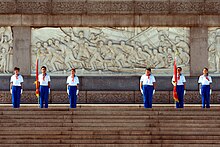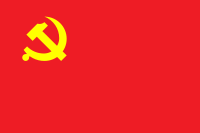Young Pioneers of China
| Young Pioneers of China 中国少年先锋队 | |
|---|---|
 Motto: "To fight for the cause of communism: Be ready! — Always ready!" (Chinese: 准备着:为共产主义事业而奋斗 — 时刻准备着!) | |
| Chairperson | |
| Founded | 1924; officially 13 October 1949 |
| Headquarters | Beijing |
| Membership | 130 million (2007)[1] |
| Mother party | Communist Party of China Communist Youth League of China |
| International affiliation | International Committee of Children's and Adolescents' Movements (historical)[citation needed] |
| Newspaper | China Children's News China Teenagers' News |
| Website | 61 |



The Young Pioneers of China (simplified Chinese: 中国少年先锋队; traditional Chinese: 中國少年先鋒隊; pinyin: Zhōngguó shàonián xiānfēngduì; abbr. simplified Chinese: 少先队; traditional Chinese: 少先隊; pinyin: shàoxiānduì) is a mass youth organization for children aged six to fourteen in the People's Republic of China. The Young Pioneers of China is run by the Communist Youth League, an organization of older youth that comes under the Chinese Communist Party (CCP). The Young Pioneers of China is similar to Pioneer Movements that exist or existed in many Communist countries around the world.
History[]
This section does not cite any sources. (July 2021) |
The Youth and Children of China Movement (simplified Chinese: 中国少年儿童队; traditional Chinese: 中國少年兒童隊; pinyin: Zhōngguó shàonián értóng duì) was created on October 13, 1949 by the CCP, and given its present name in June 1953. Between its own founding in 1921 and the founding of the People's Republic in 1949, the CCP ran various other youth movements in communist-held areas.
During the Cultural Revolution (1966–1978), the Young Pioneers Movement was temporarily dismantled. It was replaced by the , who were the younger counterparts of the Red Guards, the implementers of the Cultural Revolution. The Young Pioneers Movement was restarted in October 1978.
The transfer of sovereignty of Hong Kong and Macau in 1997 and 1999 respectively has not seen the expansion of CCP organizations (except two small working committees in Liaison Office of HK & Macau) to those areas, including the Young Pioneers.
Membership[]
Young Pioneers consist of children between the ages of six and fourteen; upon reaching the age of fourteen, members automatically exit the Young Pioneers and may go on to join the Communist Youth League.[2]
Most elementary school students are Young Pioneers by the time they graduate from grade school. Most of the schools require students of the right age to become Young Pioneers.[3] There were an estimated 130 million Young Pioneers in China, as of 2002.[4]
Organization[]
According to the Young Pioneers constitution,[2] each school or village organizes a Pioneer Battalion (simplified Chinese: 大队; traditional Chinese: 大隊; pinyin: dàduì), which is divided into Pioneer Companies (simplified Chinese: 中队; traditional Chinese: 中隊; pinyin: zhōngduì) each corresponding to a class, which is then further divided into Pioneer Squads/Teams (simplified Chinese: 小队; traditional Chinese: 小隊; pinyin: xiǎoduì) each with a handful of members. Each team has a leader (simplified Chinese: 队长; traditional Chinese: 隊長; pinyin: duìzhǎng) and an assistant leader (simplified Chinese: 副队长; traditional Chinese: 副隊長; pinyin: fùduìzhǎng), ; each of the school Companies is led by a committee of between three and seven members; and a Young Pioneers Committee (simplified Chinese: 队委会; traditional Chinese: 隊委會; pinyin: duìwěihuì) of between seven and fifteen members serve as the battalion leadership staff. Adult leaders are chosen from either the Communist Youth League or from local teaching staff (called counselor, simplified Chinese: 辅导员; traditional Chinese: 輔導員; pinyin: fǔdǎoyuán).
Young Pioneers are also directed by a number of Working Committees (simplified Chinese: 少先队工作委员会; traditional Chinese: 少先隊工作委員會; pinyin: Shǎoxiānduìgōngzuòwěiyuánhuì or Chinese: 少工委; pinyin: Shǎogōngwěi in short) at different levels over the battalion level up to the National Permanent Standing Commission (simplified Chinese: 中国少年先锋队全国工作委员会; traditional Chinese: 中國少年先鋒隊全國工作委員會; pinyin: zhōngguóshǎoniánxiānfēngduìquánguógōngzuòwěiyuánhuì or simplified Chinese: 全国少工委; traditional Chinese: 全國少工委; pinyin: Quánguóshǎogōngwěi in short), Working Committees of different levels are responsible to the Congresses of Young Pioneers (simplified Chinese: 少先队代表大会; traditional Chinese: 少先隊代表大會; pinyin: Shǎoxiānduìdàibiǎodàhuì or simplified Chinese: 少代会; traditional Chinese: 少代會; pinyin: Shǎodàihuì in short) at the same level. The current chairperson of the NPSC-YPC is Fu Zhenbang(Chinese: 傅振邦)
Constitution[]
The Constitution was officially passed on June 1, 1954, on international Children's Day. It has since been amended many times. The full text is available on Wikisource.
Symbols[]
Flag[]
According to the Young Pioneers Constitution, the flag is red, symbolizing the victory of the Revolution; the five-pointed star in the middle symbolizes the leadership of the CCP, while the torch symbolizes brightness down the path of communism.
The Pioneer Battalion flag is 90 x 120 cm, while the flag of each Company is 60 x 80 cm, with an isosceles triangle (60 x 20 cm) removed from the right side. The removed triangle corresponds to the red scarf worn by Young Pioneers.
Emblem[]
The emblem consists of the star, the torch, and a banner reading "The Young Pioneers of China".
Scarf[]
The red scarf (红领巾 hónglǐngjīn) is the only uniform item. Young Pioneers are often referred to simply as "Red Scarves"; the investiture ceremony often consists of new members having their scarves tied for them by existing members. Children wearing red scarves are a ubiquitous sight in China.
The red scarf is generally worn around the neck and tied, with no woggle. Some local groups also come up with other uniform items.
The Young Pioneers Constitution explains that the scarf corresponds to the missing triangle on the Pioneer Company flag. The Constitution also explains that the red of the scarf comes from the blood sacrificed by martyrs of the Revolution, and that all members should therefore wear the scarf with reverence.
Salute, Slogan, Conduct, Promise[]
The Young Pioneers Salute consists of bending the right arm and raising the right hand directly above the head, the palm flat and facing downwards, and the fingers together. It symbolizes that the interests of the People supersede all.
The Motto (and Summons) is:
- Chinese: 准备着,为共产主义事业而奋斗!
- (pinyin: Zhǔnbèizhe, wèi gòngchǎnzhǔyì shìyè ér fèndòu!)
- Translation: "To struggle for the cause of Communism, be prepared!"
To which the response is:
- Chinese: 时刻准备着!
- (pinyin: Shíkè zhǔnbèizhe!)
- Translation: "Always prepared!"
The stipulated conduct of Young Pioneers, according to the constitution, is:
- Chinese: 诚实、勇敢、活泼、团结
- (pinyin: chéngshí, yǒnggǎn, huópō, tuánjié)
- Translation: Honesty, Courage, Vivacity, Unity
The Young Pioneers pledge is:
- Chinese: 我是中国少年先锋队队员。我在队旗下宣誓:我热爱中国共产党,热爱祖国,热爱人民,好好学习,好好锻炼,准备着:为共产主义事业贡献力量。
- (pinyin: Wǒ shì Zhōngguó Shàonián Xiānfēngduì duìyuán. Wǒ zài Duìqí xià xuānshì: wǒ rè'ài Zhōngguó Gòngchándǎng, rè'ài zǔguó, rè'ài rénmín, hǎohǎo xúexí, hǎohǎo duànliàn, zhǔnbèizhe: wèi gòngchǎnzhǔyì shìyè gòngxiàn lìliàng.)
- Translation: I am a member of the Young Pioneers of China. Under the Flag of the Young Pioneers I swear: I will love the Communist Party of China, the motherland, and the people; I will study hard, strengthen myself [lit. exercise well], and prepare thus: to contribute my strength to the cause of communism.
Song[]
The Young Pioneers song is We are the heirs of communism (Chinese: 《我们是共产主义接班人》; pinyin: Wǒmen shì Gòngchǎnzhǔyì Jiēbānrén). It was originally the theme song of Heroic Little Eighth-Routers (Chinese: 《英雄小八路》; pinyin: Yīngxióng Xiǎo Bālù ), a 1961 film about the 1958 Second Taiwan Strait Crisis and a real-life group of children who stayed on the frontlines of coastal Fujian in order to help the war effort against Kuomintang forces. Listen to the song here.
Full dress uniform[]
Similar to other members of the Pioneer movement worldwide, the full dress uniform is white or blue shirt or polo with undershirt (or skirts for girls) and pants with the red scarf and badges attached to the shirt, with an optional headdress such as a beret. Sometimes even school uniforms are used, the addition being the red scarf, the optional headdress cap and the organizational and rank badges. During sports events YPs wear athletic uniforms.
See also[]
- Vladimir Lenin All-Union Pioneer Organization
- Ernst Thälmann Pioneer Organisation
- All-China Federation of Trade Unions
- All-China Women's Federation
References[]
- ^ "中国1.3亿少先队员将举行全国代表大会_CCTV.com_中国中央电视台" [China's 130 million young pioneers to hold a national congress]. news.cntv.cn. May 30, 2010.
- ^ Jump up to: a b "中国少年先锋队章程-中国少年先锋队" [China Youth Pioneer Charter]. zgsxd.k618.cn.
- ^ "All Chinese Private Colleges to Have Communist Youth Groups". en.people.cn. July 23, 2003.
- ^ "社区、农村两大难点考验少先队" [Two major difficulties in the community and the countryside test the Young Pioneers]. www.people.com.cn. April 13, 2002.
- Pioneer movement
- Chinese Communist Party
- Youth organizations established in 1949
- Communist Youth League of China
- 1949 establishments in China
